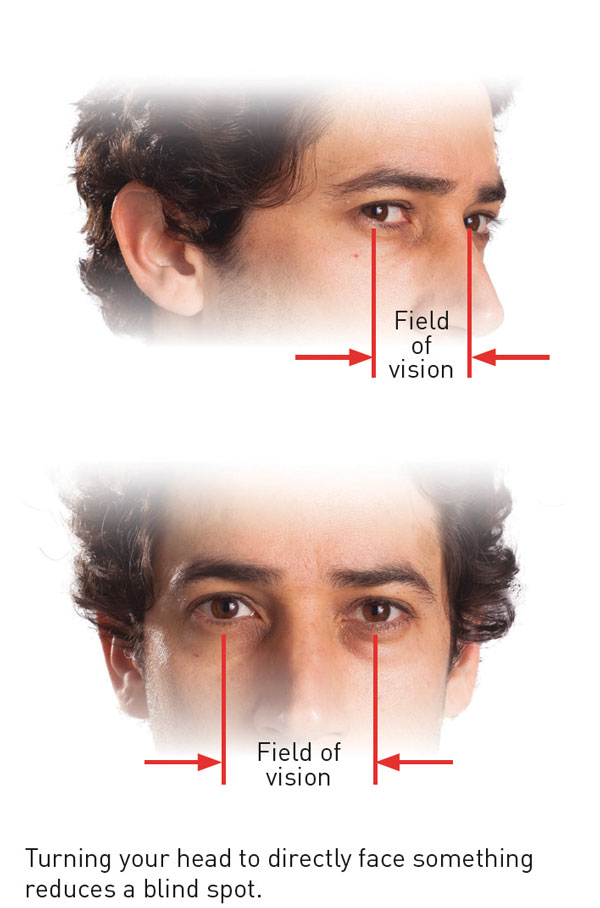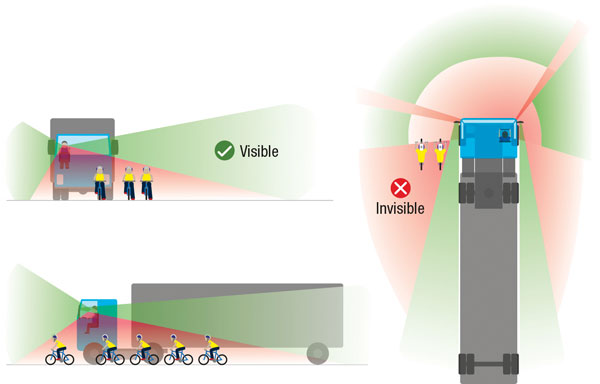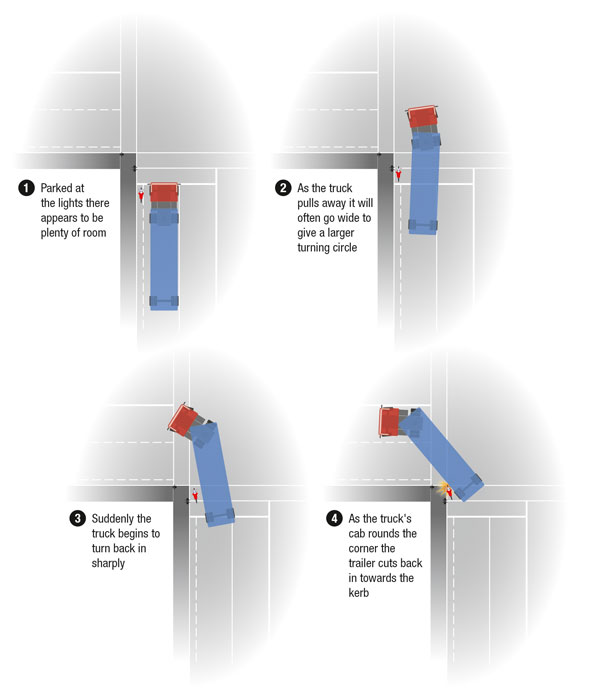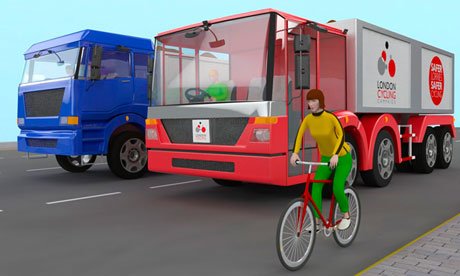Vehicle blind spots and carelessness are a deadly combination. Simon Vincett reveals how blind spots happen, how to reduce them and how bike riders can stay out of harm’s way.

Blind spots around large vehicles blot out regions of the road much larger than most people realise. These are areas that the driver cannot see by looking directly or using a mirror.
The frames surrounding the car’s windscreen (called A pillars) and windows also create blind spots that can be significant. A 2011 RACV study found “in some vehicles tested, a pedestrian or cyclist as close as nine metres away and a vehicle 20 metres away couldn’t be seen by the driver because the design of the vehicle created a side blind spot.”
The study also noted: “It’s particularly important when drivers approach intersections, especially roundabouts, to keep sight of other vehicles as you give way.” This includes a readiness for drivers “to move their head to look around them when necessary.”

In many modern cars the A pillars have been made thicker to house airbags or for other features in aid of the driver’s safety in the event of a crash. While this means safer cars, it also means driver visibility can be affected. The RACV’s report suggests that the motoring industry address this issue: “Manufacturers must ensure there is a good balance between crash safety and visibility” it states.
Driver behaviour
Addressing driver behaviour is a key way to prevent collisions, especially since ‘blind spots’ to the side and behind a car are eliminated by the driver turning their head to check before they turn or change lanes. To neglect to perform a head-check is simply carelessness.
If a driver of any vehicle—car or truck—slows appropriately for a turn and does multiple, careful checks of the side mirrors, being ready to stop if necessary, s/he significantly reduces the possibility of his blind spot obscuring a rider.

Drivers should also be aware that turning the whole head, not just the eyes, increases the field of vision and decreases the effect of a blind spot, as the field of vision is wider and isn’t impeded by the nose.
Blind spots and trucks
There are regions of the road around large vehicles that the driver actually cannot see by looking directly or using a mirror. The mirrors show a narrow corridor down the side and the solid body of the vehicle prevents the driver from turning and looking directly. This leaves an unseen area that could easily contain a bike rider or two.
How many bike riders can a truck blind spot hide? After too many fatal collisions between trucks and bike riders, in 2010 Transport for London posted an alarming video to illustrate. From the perspective of a driver of a semitrailer, the camera focusses on what can be seen in the left-hand-side mirrors. The truck is stopped at the lights and indicating to turn left. The mirrors clearly show nothing alongside. Then the camera moves out of the drivers cab and around beside the truck. Revealed are at least 12 bike riders waiting two abreast along the kerb. It’s equivalent to an illusionist’s trick but repeat viewings of the video are equally convincing, and chilling.
[youtube=http://www.youtube.com/watch?v=wzL0Kyk4m-8&w=560&h=315]
Large vehicles, such as trucks, tourist coaches and buses, are a challenge for bike riders because they take up so much room in the traffic lane. This is room that bike riders are accustomed to having available to pass on the left-hand side when there isn’t a bike lane. However, when sharing the road with larger vehicles, in this case the left side is a highly risky place to be.
The drivers of these vehicles are professionals and are adept at piloting their huge transporters in heavy traffic and through tight intersections. For all their driving prowess, however, they simply cannot see what their mirrors don’t show them. While large-vehicle mirrors and vision aids should be improved, bike riders need to be aware of the extents of the blind spots of these vehicles and ride defensively. It is legal to ride up the left hand side of these vehicles but it’s dicing with death. Collisions in which a large vehicle runs over a bike rider when turning left are a small proportion of all collisions, but they are usually serious and often fatal.
Graeme Higgins is an instructor who runs courses for heavy-goods drivers. He is also a bike and motorbike rider, so understands the needs and concerns of both riders and drivers. “We tell our drivers that observation and planning are paramount,” he told Ride On. “Give riders a bit of room if possible. Long vehicles can cause a draft and riders can be quite intimidated by a huge truck coming up beside them.
“There needs to be a bit of understanding from both the rider and the driver: riders need to understand that a truck driver sometimes can’t see them, even if a rider is right next to the driver’s window. Awareness is important from both parties.”

There are some tips for riders to follow when sharing the road with a truck or other large vehicle. The major blind spots for a large vehicle are directly behind and to the side. Reversing alarms reduce the danger of the rear blind spot. The right-hand blind spot is dangerous when overtaking: the rider must be aware that they might not be seen if the large vehicle pulls out to the right. Don’t move into a space in front of a truck—even if it’s a bike box—because the blind spot under the windscreen often stretches more than two metres ahead, which is enough to hide you.
However, it’s the left-hand blind spot that is most perilous to the pedaller. When a large vehicle begins to turn, the ample alley down the inside closes up on the unwary rider like a ton of bricks.
You’ve probably noticed that the trailing wheels of a long vehicle cut in a lot tighter to the kerb than the front wheels when it turns. It’s frightening how easy this is to misjudge, however. Even when there’s a bike lane and the large vehicle starts the turn from wider out, the bike lane is quickly overrun. Furthermore, the side mirrors of an articulated truck become even less useful when the truck is partially turned while waiting at an intersection. The problem is that the mirror ends up pointing at the side of the truck instead of the road to the side and potentially the unwary bike riders waiting there. This effect is seen in the Transport for London blind spot video.

Trucks often display a ‘Do not overtake turning vehicle’ sign to remind other road users of how much the truck overlaps other lanes when it’s turning. In fact, large vehicles will sometimes pull out right before turning left to improve their turning circle. With blind spots as large as they are, it’s imperative that bike riders assume they haven’t been seen—even if they are technically in the right—and stay well back to allow the large vehicle to make its turn.
Battling blind spots
In an effort to reduce the hazard of blind spots, the London Cycling Campaign in their Safer Lorries Pledge has called for trucks to meet four conditions before being able to drive in London.
- “A close-proximity warning system (visual or audible) to make the driver aware of cyclists and pedestrians who might hidden from view. This can include an appropriate CCTV camera or Fresnel lens where this provides an adequate alternative.
- A Class VI mirror, sideguards, and prominent signage on the rear of the lorry warning cyclists not to undertake.
- An external warning device to ensure nearby road users are aware of a planned manoeuvre.
- The haulier will be a member of a reputable best-practice safety organisation.”
The London Cycling Campaign have even proposed a new truck design that includes lowered driver’s seat, enlarged windows and expanded and additional side mirrors. Of course it will take time for these sorts of developments to be adopted by manufacturers and for these new style trucks to come into regular use. However, some of these improvements are already appearing on European large vehicles as various governments recommend and create regulations to reduce the risk of collisions with bike riders.
CEMEX is a global building-materials company with numerous delivery trucks across the world. They have recently fitted their new trucks with proximity sensors on the sides of the vehicles, which pick up any movement along the left-hand side of the vehicle and give an audible warning to riders and the driver. There is also signage along the sides and rear of the truck and a front blind-side mirror enables the driver to see bike riders and pedestrians directly at the front of the cab.
Up until recently, at least one person each year was either killed or suffered life-changing injuries from collisions with CEMEX trucks. Since the safety features have been installed, there have been no deaths or injuries.
A bit about buses
A common large vehicle you might encounter is a bus. Being surrounded by more windows, a bus driver has somewhat better visibility compared to a truck driver. In fact, the glass front door for alighting passengers eliminates the problem of riders being right beside the driver but still obscured.
However, a bus is an even more risky vehicle to pass on the left. There’s still significant blind spot there and the nature of the vehicle is that it regularly pulls in to the kerb to accommodate passengers. Being on the inside of a bus, therefore, is a recipe for getting squashed.
Instead, you get a chance to pass a bus on the right when it pulls over for passengers and leaves space on the outside of the left lane. Otherwise if the bus moves into the right lane because the left lane has parked cars you will be able to get through.
Alistair Cumming, bike rider and VicRoads Manager of Integrated Transport Engineering, notes “The average speed of a bus and a bike is very similar. This is why you leap frog with buses when your journeys coincide. I like to hang back unless I’m sure I have time to overtake. There’s generally enough room to pass to the right within the lane.”
You must give way to a bus indicating that it is pulling away from the kerb. If the bus is not indicating you can overtake and the driver is obliged to indicate before pulling out.
It may be legally permissible to overtake a bus on the left in some situations but it’s always going to be a gamble. If it’s a bus lane you probably can’t ride there for long anyway. Generally other vehicles, including bikes, are allowed to travel in the bus lane for a short distance such as 100m in order to make a left turn. Vehicles other than buses are allowed to travel in the bus lane when road signs specifically state they are. If your regular commute is on a bus route it could be worth investigating an alternative way to go to avoid this tricky conflict.
Tips for drivers
- Turn your head to check blind spots before turning and merging.
- Move your head to see around window frames when scanning on approach to an intersection.
- Make turns slowly, being ready to stop if necessary, while making multiple, careful checks of the side mirrors.
Tips for riders
- Assume that drivers haven’t seen you.
- Do not pull up on the left side of a large vehicle.
- If the truck comes alongside you, resist the urge to shrink into the gutter because that actually makes you less visible.
- Do not overtake a turning large vehicle.
- If a large vehicle turns in front of you, take evasive action by escaping onto the footpath.
Ride On content is editorially independent, but is supported financially by members of Bicycle Network. If you enjoy our articles and want to support the future publication of high-quality content, please consider helping out by becoming a member.


A good and helpful article.
I note with interest that the door pillars were made thicker to house airbags.
I remember when thick pillars first arrived. I found them disconcerting. Up to that point the pillar had to be less than the width between the drivers eyes.
Having somewhere to house airbags does sound good at first.
It perpetuates the same old problem though.
In this instance they have less visibility for other road users that they can now hit more easily who dont have the benefit of airbags. No physical protection such as helmets can ever be enough protection from a car and research indicates they may never have had anything like the claimed benefit either.
Its a failure of policy when it comes to priorities.
We protect the driver but take away part of his ability to know what is going on around him while operating a dangerous machine.
Not to mention the safer the driver is made to feel the more complacent his behaviour.
Not sure about the bus lanes comment. Most bus lanes however long allow cyclists for their entire length. But agreed that buses and cycles don’t mix, despite local councils thinking they do.
Now put a pair of glasses on the driver and see how the field of vision is adversely affected!
I wear glasses and am aware that, when looking over my shoulder, my field of vision is still significantly reduced.
There needs to be vehicle road worthiness legislation in place regarding adequately addressing blind spots in all vehicles. Blind spots can be significantly reduced using additional rear viewing devices (normally mirrors); however, these additional devices should be compulsory.
I now always wear a hi-visibility jacket and lights on my helmet and what a difference that makes. Hi-visibility vest is ok but not enough as your arm is a big visibility area. A driver opened his window at a red light and thanked me for being visible as he was just as afraid to hit a bicycle I was of cars and trucks. Drivers can do a lot but we can do even more to prevent the accident. Dont wait for a change in attitude among drivers.
I drive a Nissan Patrol, side blind spots are large and the front pillar is as thick as any. The solution here was;1 the check each direction twice, once and then again just prior to moving. on numbers of times I see the hazzard on the second look, 2.One can buy stick on small diminishing onto the outside mirrors and if properly positioned will eliminate the blind spot.
Great and informative article. I have just completed a bicycle touring trip in France and purchased a bike with Schawlbe Marathon tyres which have a reflective trim on the side walls.
Great idea for additional visibility. I have heard that this design is now compulsory in countries such as Denmark. Certainly a great idea in increasing safety; and it works!
Cert
i where high vise in the morning people in buses and cars dont look and dont see you ,even with a flashing light on my helment.you must allways be prepared to give way.
I don’t understand how the more modern vehicles are allowed to have side mirrors that make the things you are looking at, look further away than they actually are. That’s ludicrous. Can anyway give me a good example of why this is.
Excellent article and an especially good point made by Anders about cyclists doing more to ensure thier own safety. I am a regular cyclist and I think another, perhaps more important point to be made in respect of left turning vehicles and cyclists, is that cyclists are riding vehicles under the RTA and must not pass left turning vehicles on the left. Riders must give way. All too frequently I see cyclists continue into the path of left turning vehicles expecting them to give way. Perhaps its the green paving on the cycle lane at intersections that portrays an illusion of ‘right of way’ I don’t know nevertheless cyclists must give way to left turning vehicles turning in front of them.